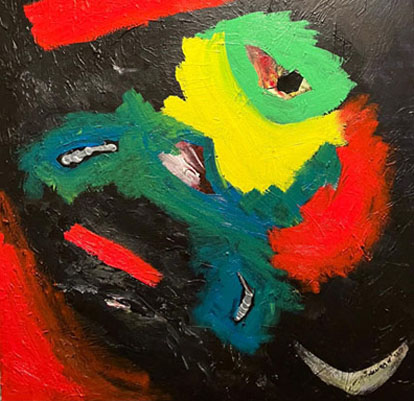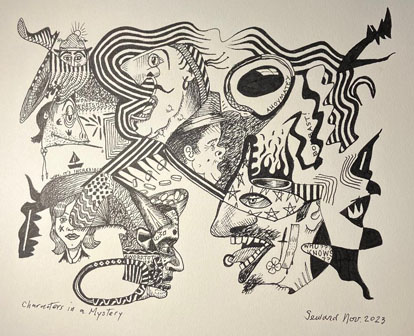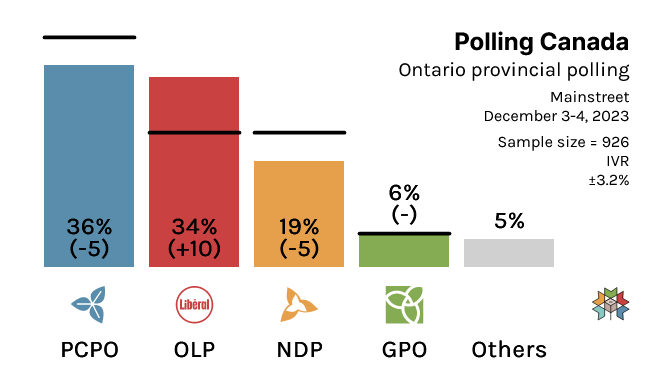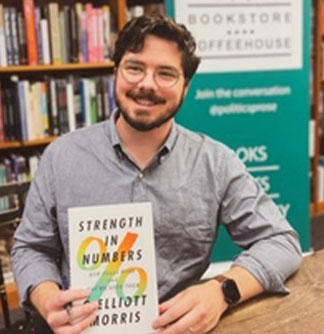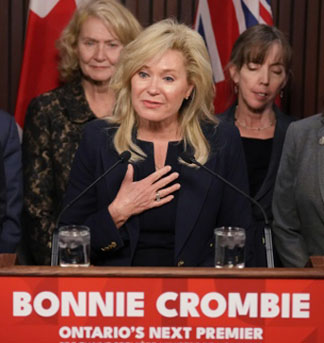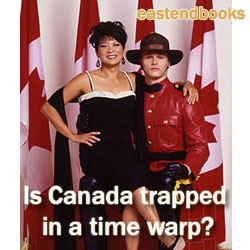Crombie and polls : 2026 voter turnout in Ontario should at least crack 50% again
Dec 8th, 2023 | By Randall White | Category: In BriefNORTH AMERICAN NOTEBOOK. RANDALL WHITE, FERNWOOD PARK, TORONTO . FRIDAY, DECEMBER 8, 2023. This is about polls in general, and one poll in particular.
The particular case is a Mainstreet Research Ontario politics poll taken immediately after Bonnie Crombie became the new leader of the Ontario Liberal Party. And the good news here is good for Ontario Liberals under their new leader, and bad for pretty much everyone else (with a half-exception for Mike Schreiner’s Green Party of Ontario).
As reported by Polling Canada the results of the December 3-4, 2023 poll are : PCPO (ie the Ford Nation Conservatives) : 36% (-5) ; OLP (Bonnie Crombie’s Liberals) : 34% (+10) ; ONDP (New Democrats) : 19% (-5) ; GPO (Mike Schreiner’s Green Party — which thanks to the recent Kitchener Centre by-election now has two seats in the legislature) : 6% (-) ; and Others: 5%.
The numbers in brackets indicate “% Change with 2022 Election.” The main point in this Mainstreet poll, taken December 3-4, with Bonnie Crombie just elected new Liberal leader on December 2, can be quickly summarized. The traditional Grits under Ms Crombie’s leadership have almost instantly gained 5 points from the Conservatives at the last election, and 5 points from the New Democrats. Already the new Crombie Liberals are within striking distance of the Ford nation.
The General Case : Molly Jong-Fast on “Let’s Stop Treating Polls as Actual News Events”

If this has happened in the first few days of a dynamic new leadership, it could be urged, what are the prospects for the next two and a half years, leading to the next fixed-date election on June 4, 2026? And I think there is something to this.
Yet this particular poll, like many others lately, in Canada and beyond, also reminds me of a recent more general Vanity Fair article by Molly Jong-Fast in the USA : “Let’s Stop Treating Polls as Actual News Events … The stakes of 2024 are too important for the media to obsess over every ‘snapshot’ of the electorate.” Here is a representative sample of four numbered quotations :
(1) Polls in effect about future elections taken some time before the election in question are “more creations of a media industrial complex that longs for easy data points, for things that feel like facts but are actually imprecise measuring mechanisms.”
(2) “The odd thing about media polls is that they are reported as a newsworthy event, but this kind of event ‘happens’ only when a newsroom decides it’s time for one — and when it has the money,’ NYU journalism professor Jay Rosen wrote in an email.”
(3) “Polls may fall into the category of pseudo-events, a term coined in 1962 by Daniel J. Boorstin and defined as something that [is] ‘planted primarily (not always exclusively) for the immediate purpose of being reported or reproduced.’”
(4) “G. Elliott Morris, editorial director of data analytics for ABC News’ FiveThirtyEight, noted in an email how “pollsters like to market their work as ‘snapshots in time’ … But they’re also subject to a lot of measurement error … Only about one out of every 100 people a pollster calls picks up the phone. [And then there are the still more slippery and increasingly prevalent online polls.] Those respondents can be really weird, politically speaking, and are also prone to overreacting to the news cycle.”
Particular voter turnout in the 2026 Ontario election could at least rise above 50% again
In both the United States and Canada we have, quite arguably, lately confronted more than a little “overreacting to the news cycle,” in eg recent strong poll showings of both the Donald Trump and Pierre Poilievre right-wing conservative brands.
Just to keep the analysis non-partisan, something of a similar sort is quite arguably at work in the new Crombie Grits’ recent strong showing in the December 3-4, 2023 Mainstreet poll. Whatever else, this is the Liberals’ best outing by some distance in polls taken since the June 2, 2022 Ontario election (according to the list of more than 20 Ontario politics polls currently assembled on the Wikipedia site “44th Ontario general election”).
To expand on the argument here just a little, the largely good reputation of polling is often traced to pollsters’ generally good record in predicting the outcome of eg Canadian federal and provincial elections, shortly before the elections take place.
At these points a usually large enough majority of the electorate is finally engaged, prior to actually voting. (Though not in two recent Ontario elections — in 2011 with a voter turnout of only 48%, and then yet again last time in 2022 with only 44% turnout, not quite 41% of whom voted for Premier Ford’s party.)
On the other hand, as G. Elliott Morris at ABC News notes, between elections the individuals who most often participate in political opinion polls in the 2020s are not highly representative of the broader democratic community that votes on election day. They are more interested in politics and perhaps more extreme or at least clearer about their political views — and again they are “prone to overreacting to the news cycle.”
Similarly, the Mainstreet poll taken just after Bonnie Crombie became Ontario Liberal leader almost certainly ignores many entitled-to-vote Canadian citizens in the province who are still only dimly if at all aware that Ms Crombie is the new provincial Liberal leader. (And note too that in Canada’s most populous province federal and provincial politics frequently blur together somewhat confusingly, in many voters’ in-between-elections minds.)
At the same time, from the way she is talking publicly Ms Crombie herself is very aware that her long journey to the 2026 next election has only just begun. Whatever else, the instant Mainstreet poll does confirm that she has now become a new force in Ontario politics.
Just what this means exactly of course remains to be seen. With a little luck, however, voter turnout in the 2026 Ontario election will at least rise above 50% once again.
